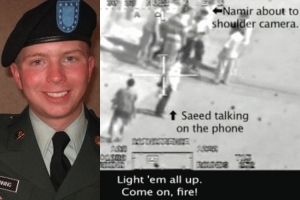The strange and consequential case of Bradley Manning, Adrian Lamo and WikiLeaksby Glenn GreenwaldJun. 18, 2010 |
Popular 
Trump Confronts South African President on White Genocide

Israeli PM Netanyahu: Trump Told Me 'I Have Absolute Commitment to You'

Trump, After Rearming Israel, 'Frustrated' With Netanyahu for Expanding War

CNN: U.S. Officials Say Israel Preparing Possible Strike on Iran

Rep. Randy Fine: Pro-Palestine Movement Are 'Demons' Who 'Must Be Put Down by Any Means Necessary'
  On June 6, Kevin Poulsen and Kim Zetter of Wired reported that a 22-year-old U.S. Army Private in Iraq, Bradley Manning, had been detained after he "boasted" in an Internet chat -- with convicted computer hacker Adrian Lamo -- of leaking to WikiLeaks the now famous Apache Helicopter attack video, a yet-to-be-published video of a civilian-killing air attack in Afghanistan, and "hundreds of thousands of classified State Department records." Lamo, who holds himself out as a "journalist" and told Manning he was one, acted instead as government informant, notifying federal authorities of what Manning allegedly told him, and then proceeded to question Manning for days as he met with federal agents, leading to Manning's detention. On June 6, Kevin Poulsen and Kim Zetter of Wired reported that a 22-year-old U.S. Army Private in Iraq, Bradley Manning, had been detained after he "boasted" in an Internet chat -- with convicted computer hacker Adrian Lamo -- of leaking to WikiLeaks the now famous Apache Helicopter attack video, a yet-to-be-published video of a civilian-killing air attack in Afghanistan, and "hundreds of thousands of classified State Department records." Lamo, who holds himself out as a "journalist" and told Manning he was one, acted instead as government informant, notifying federal authorities of what Manning allegedly told him, and then proceeded to question Manning for days as he met with federal agents, leading to Manning's detention. On June 10, former New York Times reporter Philip Shenon, writing in The Daily Beast, gave voice to anonymous "American officials" to announce that "Pentagon investigators" were trying "to determine the whereabouts of the Australian-born founder of the secretive website Wikileaks [Julian Assange] for fear that he may be about to publish a huge cache of classified State Department cables that, if made public, could do serious damage to national security." Some news outlets used that report to declare that there was a "Pentagon manhunt" underway for Assange -- as though he's some sort of dangerous fugitive. From the start, this whole story was quite strange for numerous reasons. In an attempt to obtain greater clarity about what really happened here, I've spent the last week reviewing everything I could related to this case and speaking with several of the key participants (including Lamo, with whom I had a one-hour interview last night that can be heard on the recorder below, and Poulsen, with whom I had a lengthy email exchange, which is published in full here). A definitive understanding of what really happened is virtually impossible to acquire, largely because almost everything that is known comes from a single, extremely untrustworthy source: Lamo himself. Compounding that is the fact that most of what came from Lamo has been filtered through a single journalist -- Poulsen -- who has a long and strange history with Lamo, who continues to possess but not disclose key evidence, and who has been only marginally transparent about what actually happened here (I say that as someone who admires Poulsen's work as Editor of Wired's Threat Level blog). ...READ THE FULL REPORT HERE |



